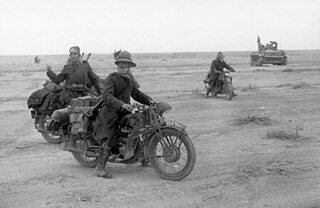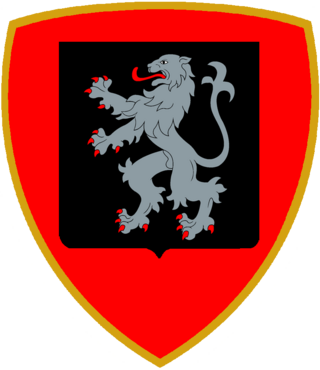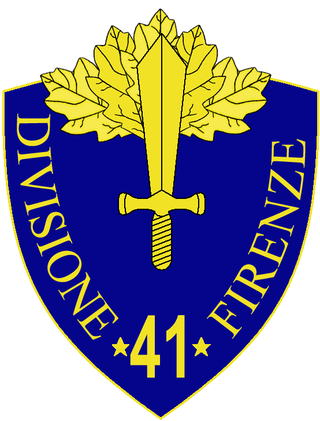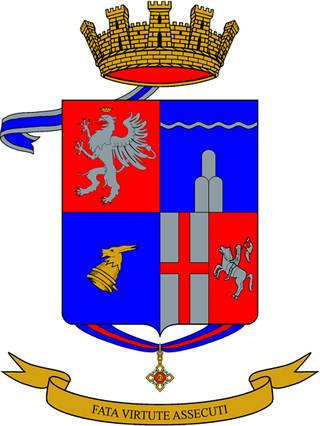Related Research Articles

Condottieri were Italian military leaders during the Middle Ages and the early modern period. The definition originally applied only to commanders of mercenary companies, condottiero in medieval Italian meaning 'contractor' and condotta being the contract by which the condottieri put themselves in the service of a city or lord. The term, however, came to refer to all the famed Italian military leaders of the Renaissance, Reformation and Counter-Reformation eras. Notable condottieri include Prospero Colonna, Giovanni dalle Bande Nere, Cesare Borgia, the Marquis of Pescara, Andrea Doria, and the Duke of Parma. They served Popes and other European monarchs and states during the Italian Wars and the European wars of religion.

The 1st CC.NN. Division "23 Marzo" was an Italian CC.NN. division raised on 23 April 1935 for the Second Italo-Ethiopian War against Ethiopia. The name "23 Marzo" was chosen to commemorate the founding date of the Fasci Italiani di Combattimento on 23 March 1919. The division took part in the Italian invasion of Egypt and was destroyed during the Battle of Bardia in January 1941.

The 1st Army was a Royal Italian Army field army, in World War I, facing Austro-Hungarian and German forces, and in World War II, fighting on the North African front.
The Great Company was a group of mercenaries, chiefly of German origin but operating in the Italian peninsula, who flourished in the mid-14th century. At its height, the company numbered approximately 10,000-12,000 men, chiefly armored cavalry. The Great Company's power set the pattern for later condottieri who came to dominate Renaissance Italian warfare.
Cavalleggeri were an inferior category of cavalry during the classic period of feudal cavalry. This included knife-armed cavalry, lancers' pages and mounted crossbowmen. Later, cavalleggeri became a subsidiary arm of the gendarmerie.

The Mechanized Brigade "Aosta" is a mechanized infantry brigade of the Italian Army based on the island of Sicily. The Brigade is one of the oldest of the Italian Army and the name connects the brigade to its original area of recruitment the Aosta Valley and therefore the brigade's coat of arms is modeled after the coat of arms of Aosta. The brigade is part of the Division "Acqui".

The 3rd Cavalry Division "Principe Amedeo Duca d'Aosta" was a Cavalry or "Celere" (Fast) division of the Royal Italian Army during World War II. The division was formed in 1934, and during World War II was mobilized in June 1940. As a cavalry division it took part in the Invasion of Yugoslavia and was part of the Italian Expeditionary Corps in Russia. Annihilated during the Red Army's Operation Little Saturn in December 1942, the survivors returned to Italy in spring 1943.

The 2nd Cavalry Division "Emanuele Filiberto Testa di Ferro" was a cavalry or "Celere" (Fast) division of the Royal Italian Army during World War II. The division was mobilised in 1940. It did not take part in the Italian invasion of France, but did serve in the Invasion of Yugoslavia and remained in Yugoslavia as part of the occupying forces. In March 1942 the division's 6th Bersaglieri Regiment was sent to the Soviet Union attached to the 3rd Cavalry Division "Principe Amedeo Duca d'Aosta". In May 1942 the division started converting to an armored division, however, the conversion was cancelled and it returned to the cavalry format. In December 1942, the division moved to France as part of the Italian occupying forces where it was based in Toulon. The division remained in France until the Armistice of Cassibile was announced on 8 September 1943 and was then disbanded by the invading Germans.

The 20th Infantry Division "Friuli" was an infantry division of the Royal Italian Army during World War II. The Friuli was formed on 24 August 1939 by splitting the 20th Infantry Division "Curtatone e Montanara" into the Friuli and the 44th Infantry Division "Cremona". The Friuli was named for the region of Friuli, but based in Tuscany, where it also recruited most of its troops. The division's headquarter and its regiments, with the exception of the 87th Infantry Regiment located in Siena, were based in Livorno. The division served as occupation force on Corsica and fought German units after the Armistice of Cassibile was announced on 8 September 1943. The division then served with the Italian Co-belligerent Army and remained active into the early stages of the Cold War.

The 41st Infantry Division "Firenze" was an infantry division of the Royal Italian Army during World War II. The Firenze was formed on 15 September 1939 in Florence and named for the city. The division recruited primarily in Tuscany. After the announcement of the Armistice of Cassibile on 8 September 1943 the division resisted German attempts to disbanded it and on 28 September 1943 the division dissolved itself and formed partisan formations, which joined the Albanian National Liberation Army.
The 225th Coastal Division was an infantry division of the Royal Italian Army during World War II. Royal Italian Army coastal divisions were second line divisions formed with reservists and equipped with second rate materiel. They were often commanded by officers called out of retirement.
The 226th Coastal Division was an infantry division of the Royal Italian Army during World War II. Royal Italian Army coastal divisions were second line divisions formed with reservists and equipped with second rate materiel. They were often commanded by officers called out of retirement.

The 156th Infantry Division "Vicenza" was an infantry division of the Royal Italian Army during World War II. The Vicenza was formed on 10 March 1942 and named for the city of Vicenza. The Vicenza was classified as an occupation infantry division, which meant that the division's artillery regiment consisted of two artillery groups instead of the three artillery groups of line infantry divisions and that the divisional mortar battalion was replaced by a divisional machine gun battalion. The division was sent to the Eastern front, as part of the Italian Army in Russia. The division guarded the army's line of communications and rear area against Soviet partisans.

The 151st Infantry Regiment "Sassari" is an active unit of the Italian Army based in Cagliari in Sardinia. The regiment is named for the city of Sassari and part of the Italian Army's infantry arm. As of 2023 the regiment is assigned to the Mechanized Brigade "Sassari".
Carlo Francovich was an Italian politician, partisan and literary historian.

The 78th Infantry Regiment "Lupi di Toscana" is an active unit of the Italian Army based in Florence in Tuscany. The regiment is named for the region of Tuscany and part of the Italian Army's infantry arm. On 1 October 2022 the name, flag and traditions of the regiment were assigned to the Command and Tactical Supports Unit "Vittorio Veneto" of the Division "Vittorio Veneto".

The 87th Infantry Regiment "Friuli" is an active unit of the Italian Army based in Bologna in the Emilia-Romagna. The regiment is named for the region of Friuli and part of the Italian Army's infantry arm. On 1 October 2022 the name, flag and traditions of the regiment were assigned to the Command and Tactical Supports Unit "Friuli" of the Airmobile Brigade "Friuli".

The 130th Infantry Regiment "Perugia" is an inactive unit of the Italian Army last based on the island of Pantelleria. The regiment is named for the city of Perugia and part of the Italian Army's infantry arm.

The 84th Infantry Regiment "Venezia" is an inactive unit of the Italian Army last based in Falconara Marittima. The regiment is named for the city of Venice and part of the Italian Army's infantry arm.

The Air Battle on Istrana was an air battle that took place in the sky over the town of Istrana on 26 December 1917, as part of the First World War. It was the most important air battle on the Italian front.
References
- This article is based on the equivalent article on Italian Wikipedia.